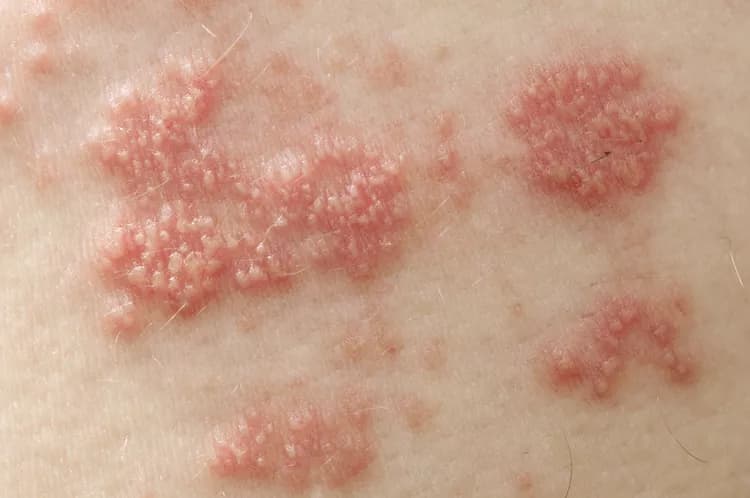What are the other Names for this Condition? (Also known as/Synonyms)
- Herpes Zoster
- HHV-3
- VZV
What is Shingles? (Definition/Background Information)
- Shingles is a viral infection caused by the reactivation of the varicella-zoster virus (VZV). This skin condition is exclusively found in individuals who had had chickenpox at some earlier point in their lives
- Chickenpox infection (or varicella) is an airborne, highly-contagious infection caused by VZV that results in the development of itchy and sometimes, painful blisters all over their body, particularly in children
- Shingles, also known as Herpes Zoster, is more often observed in older adults. The infection affects the peripheral nerves and causes patches of tiny red blisters on the body. Shingles can also involve the facial nerve, trigeminal or vestibulocochlear nerves, leading to facial paralysis, ear and eye involvement. resulting in hearing or vision loss respectively
- Shingles is a self-limiting infection that usually clears within 4 weeks or less. Symptomatic treatment is often provided, which include medications for fever, pain, and to reduce the itching sensations
- Oral antiviral medications valacyclovir and famciclovir shorten the onset of new lesions, duration, lessen pain, and lower risk of post-herpetic neuralgia (PHN). The prognosis of Shingles in normally healthy individuals is good
- In 10-20 % of cases, post-herpetic neuralgia (PHN) results after resolution of the viral phase of Herpes Zoster. This is persistent pain in the sensory nerves previously infected. The incidence and severity of PHN is greater in older and immunocompromised individuals
Who gets Shingles? (Age and Sex Distribution)
- Shingles develop only in individuals who have had previous episodes of chickenpox infection
- Both children and adults may be affected, although a majority of cases are reported in older adults (50 years or over)
- Some study reports indicate that nearly 50% of the adults aged 85 years may have experienced Shingles. Some reports also indicate that around 5% of the individuals with Shingles may get it a second time
- The condition is seen in both males and females
- No racial and ethnic preference is observed
What are the Risk Factors for Shingles? (Predisposing Factors)
The primary risk factor for Shingles is a past incidence of chickenpox or VZV infection. However, some of the triggering factors for Shingles may include:
- Aging: The greater the age, the higher is the risk, especially when associated with poor immunity
- Immunocompromised individuals, such as those with cancer or undergoing cancer therapy, recent organ or bone marrow transplant, chronic use of steroids, and HIV infection (or AIDS)
- Any surgery or injury affecting the nervous system
- Trauma or injury
- Poorly-controlled diabetes
- Severe physical and psychological stress
It is important to note that having a risk factor does not mean that one will get the condition. A risk factor increases one’s chances of getting a condition compared to an individual without the risk factors. Some risk factors are more important than others.
Also, not having a risk factor does not mean that an individual will not get the condition. It is always important to discuss the effect of risk factors with your healthcare provider.
What are the Causes of Shingles? (Etiology)
Shingles develops due to the reactivation of the varicella-zoster virus (VZV), which remains in the body following a previous episode of chickenpox. VZV is also known as human herpesvirus-3 (HHV-3).
- Following chickenpox, the virus stays dormant in the body within the dorsal root ganglia of the sensory nerves. The virus stays inactive due to the individual’s healthy and robust immune system
- The virus gets reactivated due to certain triggering factors, such as a weak immunity, or any condition that compromises the immune system. The virus then travels down the nerve pathways to the skin causing symptoms of Shingles
Even though Shingles does not spread from one individual to another, the infected individual can affect those who have never contracted chickenpox. Direct physical contact with open skin sores may result in transmission of the VZV virus, which can result in chickenpox infection.
What are the Signs and Symptoms of Shingles?
Children with Shingles are known to have milder symptoms in comparison to adults. Adults with the infection may have severe symptoms. In general, the signs and symptoms of Shingles may include:
- The first signs of Shingles include localized pain that generally extends to other skin areas served by the same sensory nerve
- Since, the sensory nerves are involved, pain, numbness and tingling sensation may be noted
- Burning skin sensation
- The individual may experience fever, chills, and headache
- Tiredness and fatigue
- Itchy skin rashes develop after 2-3 days of onset of severe pain. The rashes appear like chickenpox in irregular patches and clusters
- The red skin rashes or blisters keep appearing for about 7 days
- Within a few days, the fluid-filled blisters turn yellowish, ooze fluid, and dry out. This process result in scab formation, change in skin pigmentation, and scarring if lesions are deep
- Mild or severe pain and discomfort is felt till all the blisters dry out
- In some individuals, a pricking pain sensation may be experienced
- 5% of the affected individuals are known to have some form of muscle weakness
- In rare cases, only the pain and tingling sensation may be observed and rash development is not present. This condition is called “zoster sine eruptio´ne” or “zoster sine her´pete”
The entire duration of skin symptoms may take between 2 to 4 weeks. In most individuals, the skin rashes form on one half of the body, such as from the vertebral column to the sternum (or middle of the chest). Occasionally, the skin rashes may form around the eye (single eye), or on the face. On the face, some blisters may form inside the mouth or in the ear canal and on the eardrum too.
How is Shingles Diagnosed?
The diagnostic procedure to confirm the presence of Chickenpox Infection (Varicella) may include:
- Physical examination with medical history evaluation (including history of chickenpox): Normally, a physician may diagnose the infection based on the characteristic signs and symptoms, especially based on the the skin rashes
- A blood test for varicella zoster virus may be performed to confirm the infection, if required
- Culture studies: Culture swabs for detecting the viral species involved
- Chickenpox and Shingles test may be performed to detect and diagnose a current or past chickenpox and/or Shingles (Herpes Zoster) infection
Many clinical conditions may have similar signs and symptoms. Your healthcare provider may perform additional tests to rule out other clinical conditions to arrive at a definitive diagnosis.
What are the possible Complications of Shingles?
The complications of Shingles normally arise in individuals with poor immune function and it may include:
- Cosmetic concerns and severe stress from puckering and scarring of skin
- The skin lesions may give rise to secondary/superimposed bacterial and fungal infections
- Some individuals with poor immune system may have severe infection and spread of lesions to areas of skin outside the originally affected sensory nerve. This is termed “extradermatomal” involvement.
- Facial nerve palsy may accompany skin rashes on the face. If the involvement of the facial nerve is severe, then only a partial recovery may be experienced (in up to 50% of the cases)
- Ophthalmic Shingles (when the eye is involved) may lead to loss of vision in the affected eye
- Hearing loss
- Involvement of the internal organs, such as the digestive tract, brain, liver, or lungs. In some individuals, this condition may be potentially fatal
- Postherpetic neuralgia (PHN): 10-20% of individuals with Shingles may be affected by postherpetic neuralgia, which causes severe pain in the region after the skin lesions have disappeared due to involvement of the nerves. The nerve pain can last for several months (3-6 months) to even years, in some cases
Pregnant women, very young children, or those with severe illness, such as cancer or HIV infection, may be infected by Shingles-affected individuals, with serious outcomes possible. Patients with Shingles must be made aware of their infectious nature and quarantine from susceptible people
How is Shingles Treated?
In many cases, Shingles heals by its own within 2 to 4 weeks. Prompt diagnosis and treatment may help address the symptoms associated with the condition and bring a measure of early relief. This can also lower the risk of complications. The treatment measures for Shingles may include:
- Administration of oral antiviral medications acyclovir, valacyclovir, and famciclovir, started early in the condition within 3 days, when the patches and blisters begin to appear. This may reduce the severity and duration of the skin condition
- Pain medication that may include acetaminophen, non-steroidal anti-inflammatory drugs (NSAIDs), tricyclic antidepressants, and opiates
- Oral corticosteroids, such as prednisone, can help with acute pain. It is prescribed commonly at the beginning of the episode, then tapered
- In some individuals, gabapentin may be prescribed for severe post-herpetic neuralgia
- Topical applications such as lidocaine gels and calamine lotions
- Taking certain home care or self-care tips that would include:
- Keeping the affected skin areas clean and dry
- Avoiding covering the rashes with ‘sticky’ dressings
- Applying cool compresses (placing clean cloth soaked in room temperature water), in case of blisters that ooze
- Wearing comfortable and loose clothing
How can Shingles be Prevented?
Even though it may not be possible to completely prevent the onset of Shingles, one may lower the risk through the following vaccines:
- Shingrix is a vaccine given in two doses to patients 50 years and above. It does not contain live virus, so it is possible to use in patients with mild immunosuppression. Its use should always be discussed with one’s trusted healthcare provider. It has not been tested in pregnant or nursing women
- Shingrix can also be used in adults over 18 years of age who are at risk for Shingles because of immunodeficiency or immunosuppression
- Zostavax is a discontinued vaccine which had a live modified varicella zoster virus.
- Chickenpox vaccine: Vaccination to prevent chickenpox infection is normally a part of the children’s immunization schedule. It is also recommended in immunocompetent adults who have never been affected by chickenpox
Shingles patients are advised to remain at home, till the blisters break, dry, and heal completely. This can help prevent the spread of infection to others.
Note:
- The vaccinations are not meant to treat an active infection
- Chickenpox vaccine should not be administered to pregnant women
What is Prognosis of Shingles? (Outcomes/Resolutions)
- In a majority of cases, Shingles is a self-limiting infection that lasts between 2 to 4 weeks. The condition is best managed by early diagnosis and treatment appropriate to the individual
- Vaccination is very effective in decreasing the risk for Shingles, and severity of the disease, if it does occur
- Post-herpetic neuralgia (PHN) can be a debilitating condition. Early treatment can lessen its severity
- In rare cases, complications that involve the nervous system may cause pain, weakness, and paralysis that may last for several months
Additional and Relevant Useful Information for Shingles:
Please visit our Infectious Diseases Health Center for more physician-approved health information:
https://www.dovemed.com/diseases-conditions/infection-center/
Related Articles
Test Your Knowledge
Asked by users
Related Centers
Related Specialties
Related Physicians
Related Procedures
Related Resources
Join DoveHubs
and connect with fellow professionals



0 Comments
Please log in to post a comment.